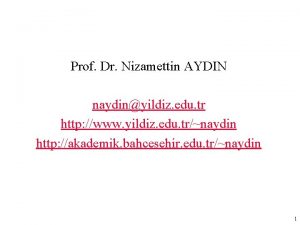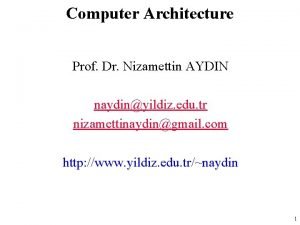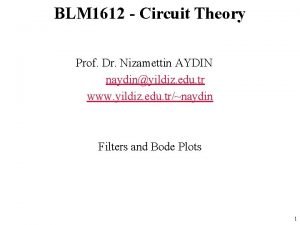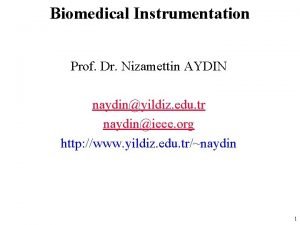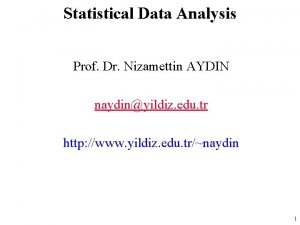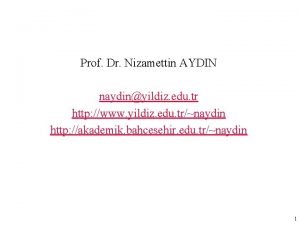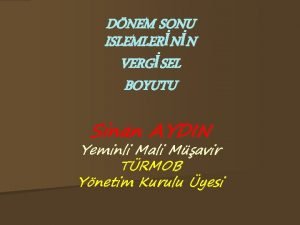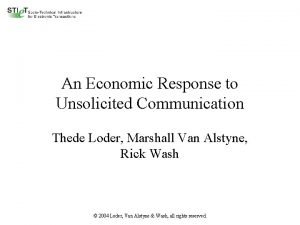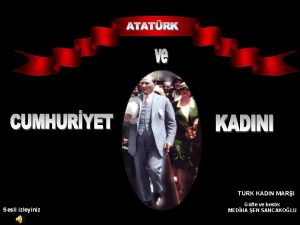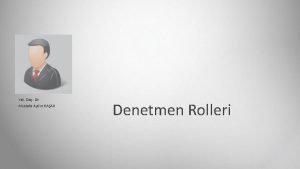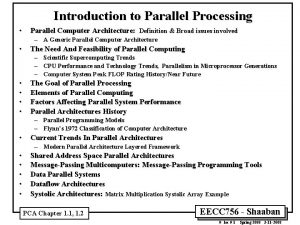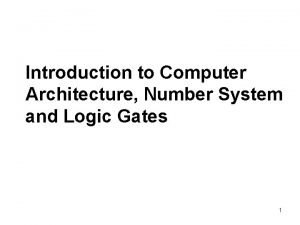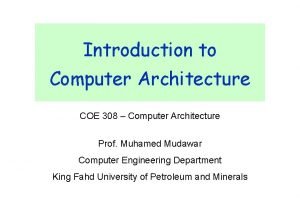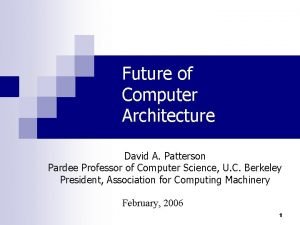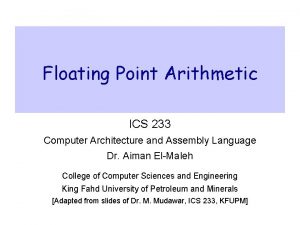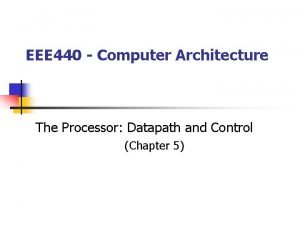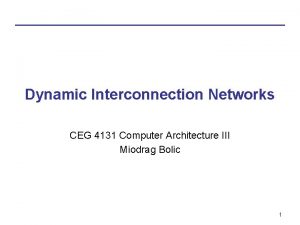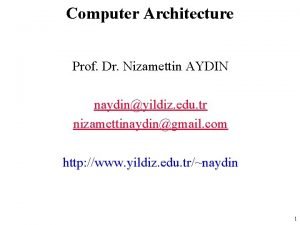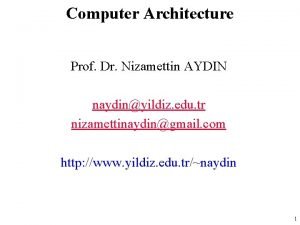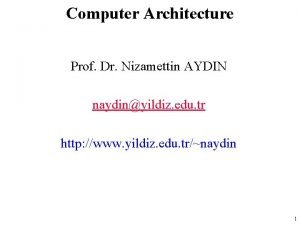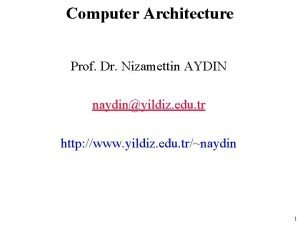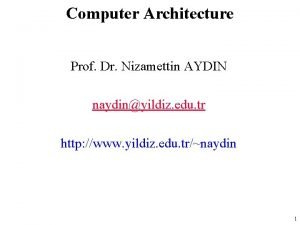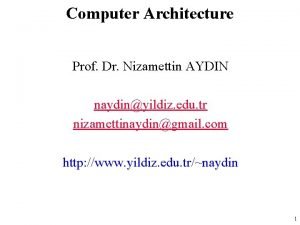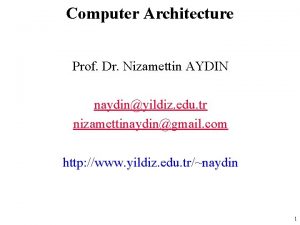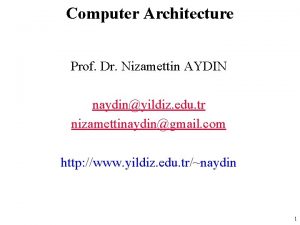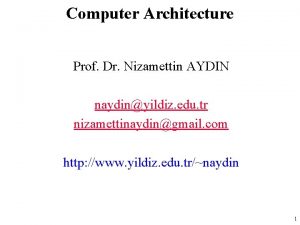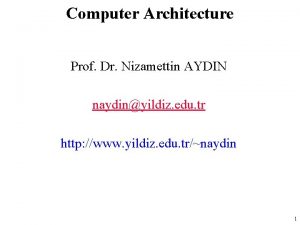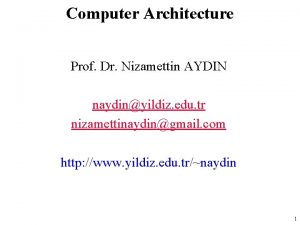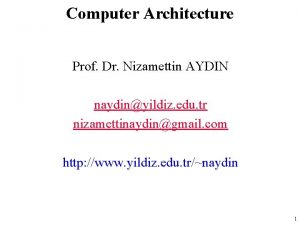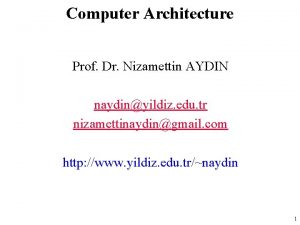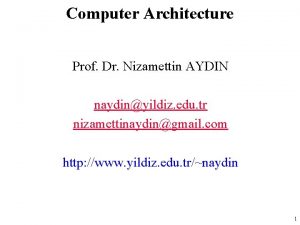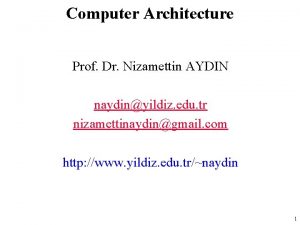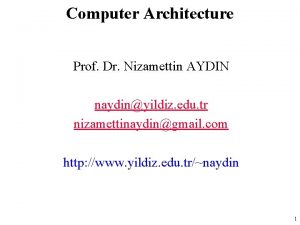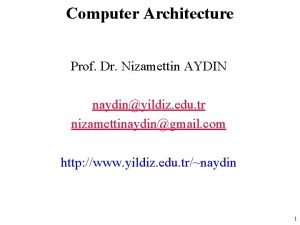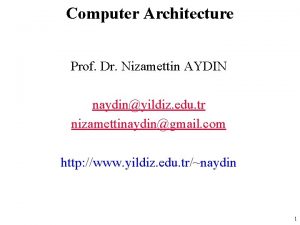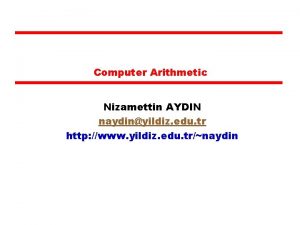Computer Architecture Prof Dr Nizamettin AYDIN naydinyildiz edu




























































- Slides: 60

Computer Architecture Prof. Dr. Nizamettin AYDIN naydin@yildiz. edu. tr nizamettinaydin@gmail. com http: //www. yildiz. edu. tr/~naydin 1

External Memory 2

Outline • Types of External Memory – Magnetic Disk • • Magnetic Read and Write Mechanisms Data Organization and Formatting Physical Characteristics Disk Performance Parameters – RAID – Solid State Drives • Flash Memory • SSD Compared to HDD • SSD Organization – Optical Memory • Compact Disk • Digital Versatile Disk • High-Definition Optical Disks – Magnetic Tape 3

Magnetic Disk • Disk substrate coated with magnetizable material (iron oxide…rust) • Substrate used to be aluminium • Now glass – Improved surface uniformity • Increases reliability – Reduction in surface defects • Reduced read/write errors – Lower flight heights – Better stiffness to reduce disk dynamics – Better shock/damage resistance 4

Write and Read Mechanisms • During read/write, head is stationary, platter rotates • Write (inductive) – Current through coil produces magnetic field – Pulses sent to head – Magnetic pattern recorded on surface below • Read (magneto resistive) (MR) – – Separate read head, close to write head Partially shielded magneto resistive (MR) sensor Electrical resistance depends on direction of magnetic field High frequency operation • Higher storage density and speed 5

Data Organization and Formatting • Concentric rings or tracks – Gaps between tracks – Reduce gap to increase capacity – Same number of bits per track (variable packing density) – Constant angular velocity • Tracks divided into sectors • Minimum block size is one sector • May have more than one sector per block 6

Disk Velocity • Bit near centre of rotating disk passes fixed point slower than bit on outside of disk • Increase spacing between bits in different tracks • Rotate disk at constant angular velocity (CAV) – – Gives pie shaped sectors and concentric tracks Individual tracks and sectors addressable Move head to given track and wait for given sector Waste of space on outer tracks • Lower data density • Can use zones to increase capacity – Each zone has fixed bits per track – More complex circuitry 7

Disk Layout Methods Diagram 8

Finding Sectors • Some means is needed to locate sector positions within a track. – There must be some starting point on the track and a way of identifying the start and end of each sector. • These requirements are handled by means of control data recorded on the disk. – Thus, the disk is formatted with some extra data used only by the disk drive and not accessible to the user. 9

Winchester Disk Format-Seagate ST 506 • An example of disk formatting: – – – Each track contains 30 fixed-length sectors of 600 bytes each. – Each sector holds 512 bytes of data plus control information useful to the disk controller. The ID field is a unique identifier or address used to locate a particular sector. The SYNCH byte is a special bit pattern that delimits the beginning of the field. The track number identifies a track on a surface. The head number identifies a head, because this disk has multiple surfaces. The ID and data fields each contain an error detecting code. 10

Characteristics • • • Fixed (rare) or movable head Removable or fixed Single or double (usually) sided Single or multiple platter Head mechanism – Contact (Floppy) – Fixed gap – Flying (Winchester) 11

Fixed/Movable Head Disk • Fixed head – One read write head per track – Heads mounted on fixed ridged arm • Movable head – One read write head per side – Mounted on a movable arm 12

Removable or Not • Removable disk – Can be removed from drive and replaced with another disk – Provides unlimited storage capacity – Easy data transfer between systems • Nonremovable disk – Permanently mounted in the drive 13

Multiple Platter • One head per side • Heads are joined and aligned • Aligned tracks on each platter form cylinders • Data is striped by cylinder – reduces head movement – Increases speed (transfer rate) 14

Multiple Platters 15

Tracks and Cylinders 16

Floppy Disk • 8”, 5. 25”, 3. 5” • Small capacity – Up to 1. 44 Mbyte (2. 88 M never popular) • • Slow Universal Cheap Obsolete? 17

Winchester Hard Disk (1) • • • Developed by IBM in Winchester (USA) Sealed unit One or more platters (disks) Heads fly on boundary layer of air as disk spins Very small head to disk gap Getting more robust Universal Cheap Fastest external storage! Getting larger all the time – Terabyte now easily available 18

Typical Hard Disk Drive Parameters • Parameters for typical contemporary high-performance disks 19

Timing of Disk I/O Transfer • The actual details of disk I/O operation depend on the computer system, the operating system, and the nature of the I/O channel and disk controller hardware. • A general timing diagram of disk I/O transfer: 20

Disk Performance Parameters-Speed • Seek time – Moving head to correct track • (Rotational) latency – Waiting for data to rotate under head • Transfer time – Depends on the rotation speed of the disk • • T: transfer time, b: number of bytes to be transferred, N: number of bytes on track, r: rotation speed, in revolution per sconds • Access time = Seek + Latency Ts: average seek time – Transfer rate 21

RAID • • • Redundant Array of Independent Disks Redundant Array of Inexpensive Disks 6 levels in common use Not a hierarchy Set of physical disks viewed as single logical drive by O/S • Data distributed across physical drives • Can use redundant capacity to store parity information 22

RAID 0 • • No redundancy Data striped across all disks Round Robin striping Increase speed – Multiple data requests probably not on same disk – Disks seek in parallel – A set of data is likely to be striped across multiple disks 23

RAID 1 • • • Mirrored Disks Data is striped across disks 2 copies of each stripe on separate disks Read from either Write to both Recovery is simple – Swap faulty disk & re-mirror – No down time • Expensive 24

RAID 2 • Disks are synchronized • Very small stripes – Often single byte/word • Error correction calculated across corresponding bits on disks • Multiple parity disks store Hamming code error correction in corresponding positions • Lots of redundancy – Expensive – Not used 25

RAID 3 • Similar to RAID 2 • Only one redundant disk, no matter how large the array • Simple parity bit for each set of corresponding bits • Data on failed drive can be reconstructed from surviving data and parity info • Very high transfer rates 26

Example: Data reconstruction in RAID 3 • Consider an array of five drives (X 0, X 1, X 2, X 3 contain data, X 4 is parity disk) • Parity of ith bit is calculated as: X 4(i)=X 3(i) X 2(i) X 1(i) X 0(i) • Suppose that drive X 1 has failed. The contents of X 1 can be regenerated as: X 1(i)=X 4(i) X 3(i) X 2(i) X 0(i) 27

RAID 4 • • Each disk operates independently Good for high I/O request rate Large stripes Bit by bit parity calculated across stripes on each disk • Parity stored on parity disk 28

RAID 5 • • • Like RAID 4 Parity striped across all disks Round robin allocation for parity stripe Avoids RAID 4 bottleneck at parity disk Commonly used in network servers 29

RAID 6 • • Two parity calculations Stored in separate blocks on different disks User requirement of N disks needs N+2 High data availability – Three disks need to fail for data loss – Significant write penalty 30

RAID 0, 1, 2 31

RAID 3 & 4 32

RAID 5 & 6 33

RAID Levels 34

Data Mapping For RAID 0 35

RAID Comparison 36

RAID Comparison 37

Solid State Drives (SSD) • A memory device made with solid state components that can be used as a replacement to a hard disk drive. • In recent years, it is used to complement or even replace hard disk drives (HDDs), – both as internal and external secondary memory • SSDs now on the market and coming on line use a type of semiconductor memory referred to as flash memory 38

Flash Memory • a type of semiconductor memory that has been around for a number of years • is used in many consumer electronic products, – smart phones, GPS devices, MP 3 players, digital cameras, and USB devices. • In recent years, the cost and performance of flash memory has evolved to the point where it is feasible to use flash memory drives to replace HDDs. • Next slide illustrates the basic operation of a flash memory 39

Flash Memory • Transistor structure – A small voltage applied to the gate can be used to control the flow of a large current between the source and the drain. • Flash memory cell in one state – A second gate, called a floating gate because it is insulated by a thin oxide layer, is added to the transistor. – Initially, the floating gate does not interfere with the operation of the transistor. – In this state, the cell is deemed to represent binary 1. • Flash memory cell in zero state – Applying a large voltage across the oxide layer causes electrons to tunnel through it and become trapped on the floating gate, where they remain even if the power is disconnected. – In this state, the cell is deemed to represent binary 0. 40

Flash Memory • Two distinctive types: – NOR flash memory • • • the basic unit of access is a bit, the logical organization resembles a NOR logic device provides high-speed random access can read and write data to specific locations, can reference and retrieve a single byte used to store cell phone operating system code and on Windows computers for the BIOS program that runs at startup – NAND flash memory • • the basic unit is 16 or 32 bits, the logical organization resembles NAND devices reads and writes in small blocks used in USB flash drives, memory cards (in digital cameras, MP 3 players, etc. ), and in SSDs • provides higher bit density than NOR and greater write speed • does not provide a random-access external address bus so • the data must be read on a blockwise basis (also known as page access), where each block holds hundreds to thousands of bits 41

SSD Compared to HDD • SSDs have the following advantages over HDDs: – High-performance input/output operations per second (IOPS): • Significantly increases performance I/O subsystems. – Durability: • Less susceptible to physical shock and vibration. – Longer lifespan: • SSDs are not susceptible to mechanical wear. – Lower power consumption: • SSDs use as little as 2. 1 watts of power per drive, – considerably less than comparable-size HDDs. – Quieter and cooler running capabilities: • Less floor space required, lower energy costs, and a greener enterprise. – Lower access times and latency rates: • Over 10 times faster than the spinning disks in an HDD. 42

SSD Compared to HDD • Comparison of Solid State Drives and Disk Drives (as of around 2013) 43

SSD Organization • • • On the host system, operating system invokes file system software to access data on the disk. The file system, in turn, invokes I/O driver software. The I/O driver software provides host access to the particular SSD product. If the device is an internal hard drive, a common interface is PCIe. For external devices, one common interface is USB. In addition to the interface to the host system, the SSD contains the following components: – Controller: • Provides SSD device level interfacing and firmware execution. – Addressing: • Logic that performs the selection function across the flash memory components. – Data buffer/cache: • High speed RAM memory components used for speed matching and to increased data throughput. – Error correction: • Logic for error detection and correction. – Flash memory components: • Individual NAND flash chips. 44

Optical Storage • CD – Compact Disk • CD-ROM – Compact Disk Read-Only Memory • CD-R – CD Recordable • CD-RW – CD Rewritable • DVD – Digital Versatile Disk • DVD-R – DVD Recordable • DVD-RW – DVD Rewritable 45

Optical Storage CD-ROM • Originally for audio • 650 Mbytes giving over 70 minutes audio • Polycarbonate coated with highly reflective coat, usually aluminium • Data stored as pits • Read by reflecting laser • Constant packing density • Constant linear velocity 46

CD Operation 47

CD-ROM Drive Speeds • Audio is single speed – Constant linier velocity – 1. 2 ms-1 – Track (spiral) is 5. 27 km long – Gives 4391 seconds = 73. 2 minutes • Other speeds are quoted as multiples • e. g. 24 x • Quoted figure is maximum drive can achieve 48

CD-ROM Format • Sync: Identifies the beginning of a block. Consists of a byte of all 0 s, 10 bytes of all 1 s, and a byte of all 0 s • Header: Contains the block address and the mode byte – Mode 0=blank data field – Mode 1=2048 byte data+error correction – Mode 2=2336 byte data • Data: User data • Auxiliary: Additional user data in mode 2. In mode 1, this is a 288 -byte error correcting code. 49

Random Access on CD-ROM • Difficult • Move head to rough position • Set correct speed • Read address • Adjust to required location 50

CD-ROM for & against • • Large capacity (? ) Easy to mass produce Removable Robust • Expensive for small runs • Slow • Read only 51

Other Optical Storage • CD-Recordable (CD-R) – WORM – Now affordable – Compatible with CD-ROM drives • CD-RW – Erasable – Getting cheaper – Mostly CD-ROM drive compatible – Phase change • Material has two different reflectivities in different phase states 52

DVD • Digital Video Disk – Used to indicate a player for movies • Only plays video disks • Digital Versatile Disk – Used to indicate a computer drive • Will read computer disks and play video disks 53

DVD - technology • Multi-layer • Very high capacity (4. 7 G per layer) • Full length movie on single disk – Using MPEG compression • Finally standardized • Movies carry regional coding • Players only play correct region films 54

DVD – Writable • Loads of trouble with standards • First generation DVD drives may not read first generation DVD-W disks • First generation DVD drives may not read CDRW disks 55

CD and DVD 56

Magnetic Tape • Serial access • Slow • Very cheap • Backup and archive • Capacity: a couple of 100 GB 57

Typical Magnetic Tape Features 58

Internet Resources • Optical Storage Technology Association – Good source of information about optical storage technology and vendors – Extensive list of relevant links • DLTtape – Good collection of technical information and links to vendors • Search on RAID 59

60
 Prof. dr. nizamettin aydin
Prof. dr. nizamettin aydin Prof. dr. nizamettin aydin
Prof. dr. nizamettin aydin Prof. dr. nizamettin aydin
Prof. dr. nizamettin aydin Prof. dr. nizamettin aydin
Prof. dr. nizamettin aydin Nizamettin aydin
Nizamettin aydin Nizamettin aydin
Nizamettin aydin Nizamettin aydin
Nizamettin aydin Sinan aydın mali müşavir
Sinan aydın mali müşavir Aydın kendirci
Aydın kendirci Thede loder
Thede loder Sevil aydın
Sevil aydın Aydın bir türk kadınıyım
Aydın bir türk kadınıyım Bushra hasan
Bushra hasan Coordination
Coordination Aydin marine
Aydin marine Aydın başar
Aydın başar Nazmi aydın
Nazmi aydın Aydin bal
Aydin bal Aydın kekemelik merkezi
Aydın kekemelik merkezi Bus design in computer architecture
Bus design in computer architecture Organization and architecture difference
Organization and architecture difference Flowchart for memory reference instructions
Flowchart for memory reference instructions Edu.sharif.edu
Edu.sharif.edu Abc in software architecture
Abc in software architecture Return architecture
Return architecture Integral product architecture
Integral product architecture Product architecture steps
Product architecture steps Computer organization and architecture 10th solution
Computer organization and architecture 10th solution Intel pentium
Intel pentium Coa virtual lab iit kharagpur
Coa virtual lab iit kharagpur Introduction to computer organization and architecture
Introduction to computer organization and architecture Timing and control in computer architecture
Timing and control in computer architecture Evolution and interpretation of computer architecture
Evolution and interpretation of computer architecture Dma controller in computer architecture
Dma controller in computer architecture Floating point division algorithm in computer architecture
Floating point division algorithm in computer architecture Lmc addressing modes
Lmc addressing modes Static interconnection network in computer architecture
Static interconnection network in computer architecture Smt in computer architecture
Smt in computer architecture Pseudo instructions are
Pseudo instructions are 111011-100100
111011-100100 Instruction format in computer architecture
Instruction format in computer architecture Nano programming in computer organization
Nano programming in computer organization Vertical microinstruction
Vertical microinstruction Memory system
Memory system Virtual memory tlb
Virtual memory tlb Which pipeline is linear
Which pipeline is linear Computer architecture definition
Computer architecture definition Parallel processing architecture
Parallel processing architecture Computer architecture number system
Computer architecture number system Computer architecture definition
Computer architecture definition What is isa in computer architecture
What is isa in computer architecture Write any three input devices
Write any three input devices Branch prediction
Branch prediction David patterson computer architecture
David patterson computer architecture Single instruction single data
Single instruction single data What is guard bit in computer architecture
What is guard bit in computer architecture Parallel priority interrupt in computer architecture
Parallel priority interrupt in computer architecture Basic mips implementation in computer architecture
Basic mips implementation in computer architecture Explain virtual memory in computer architecture
Explain virtual memory in computer architecture Computer architecture definition
Computer architecture definition Dynamic interconnection network in computer architecture
Dynamic interconnection network in computer architecture
